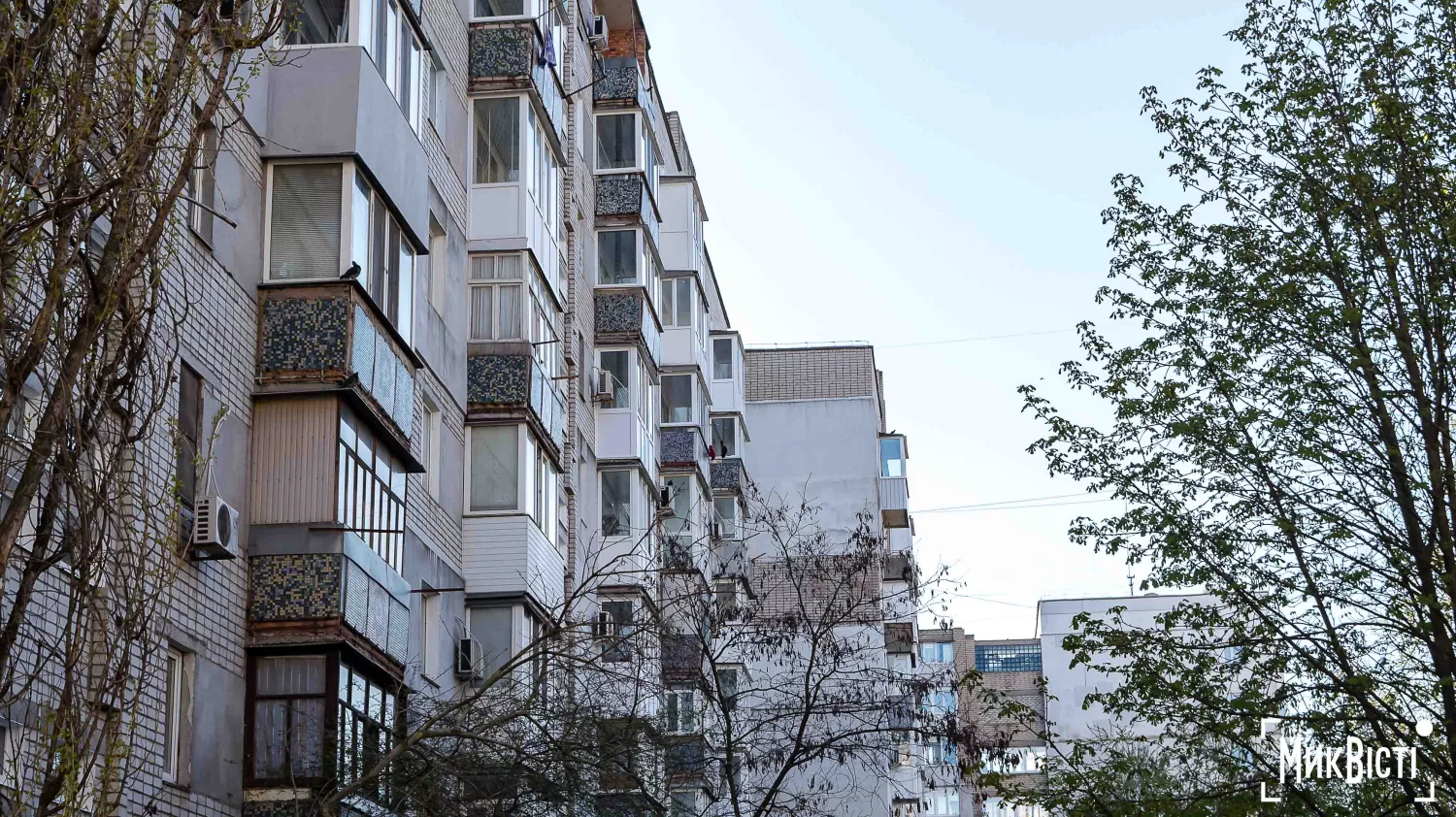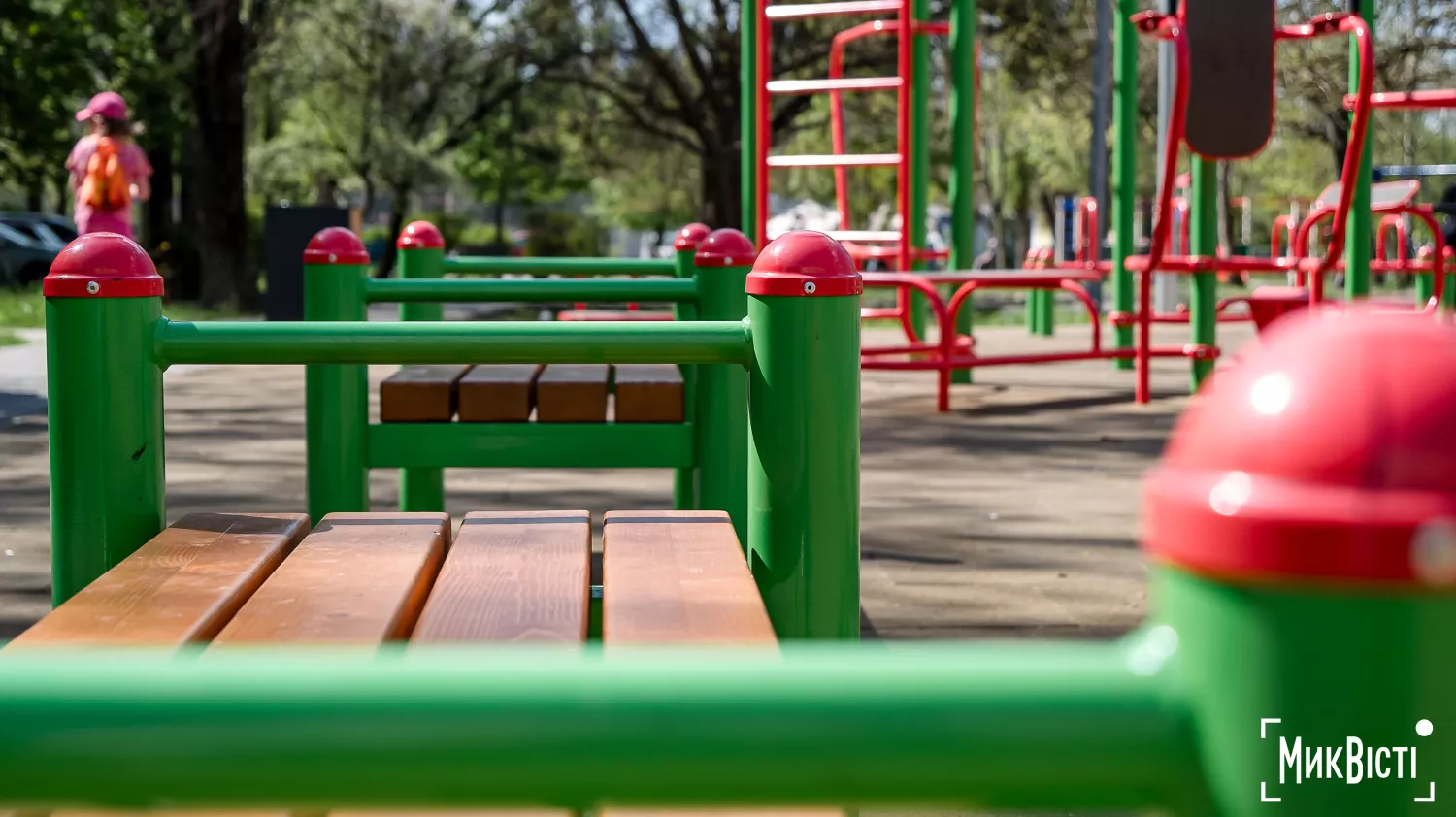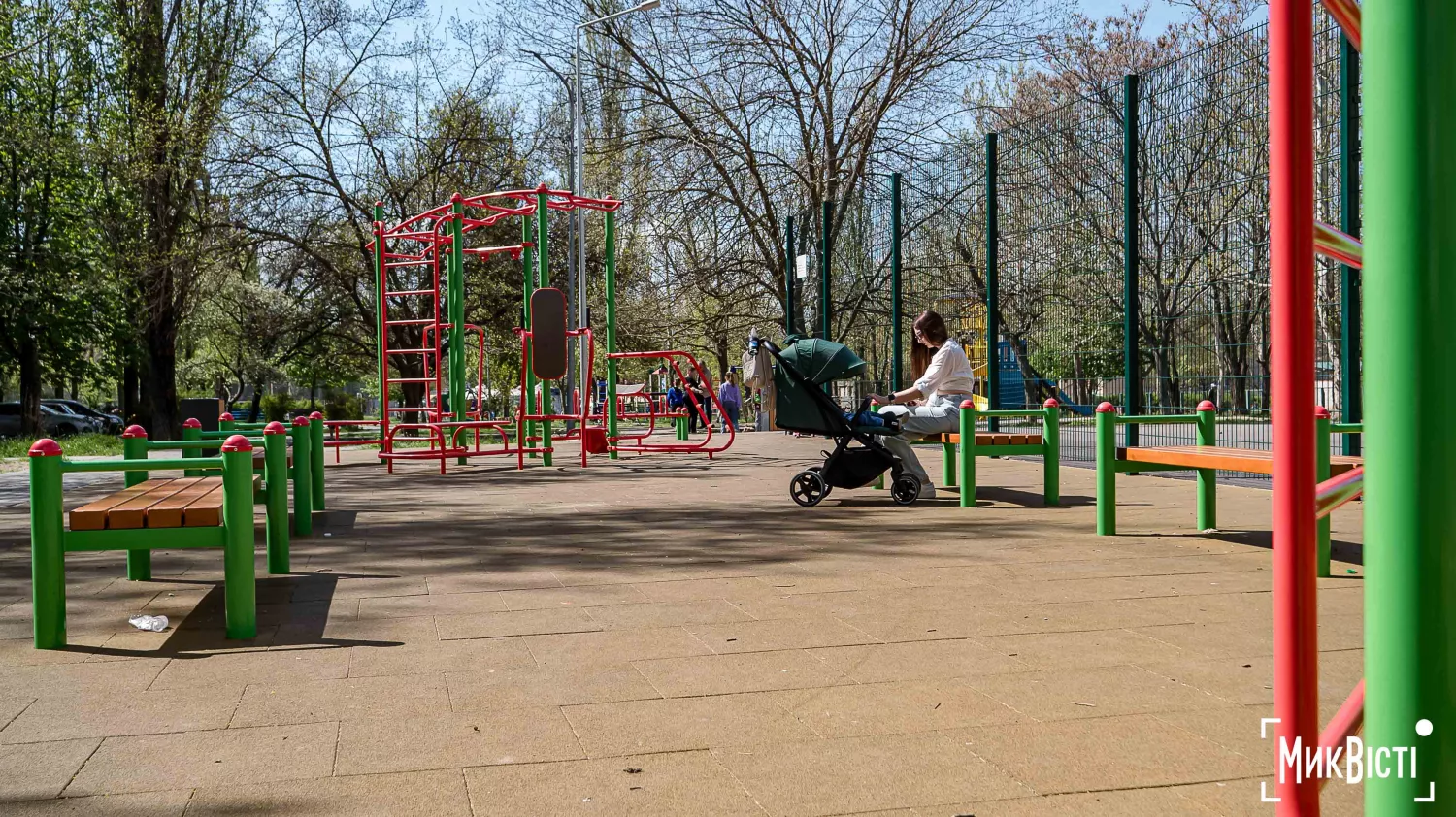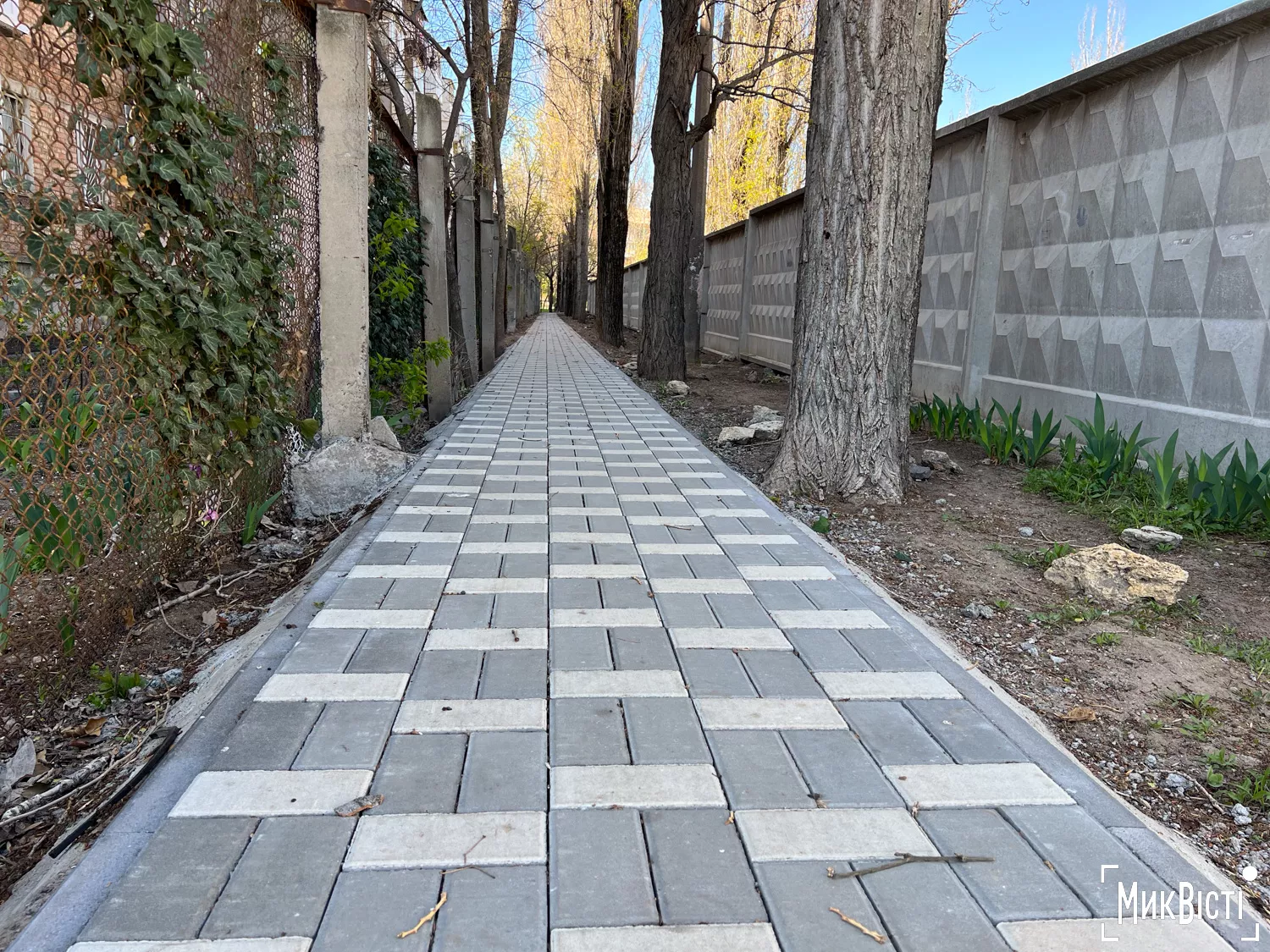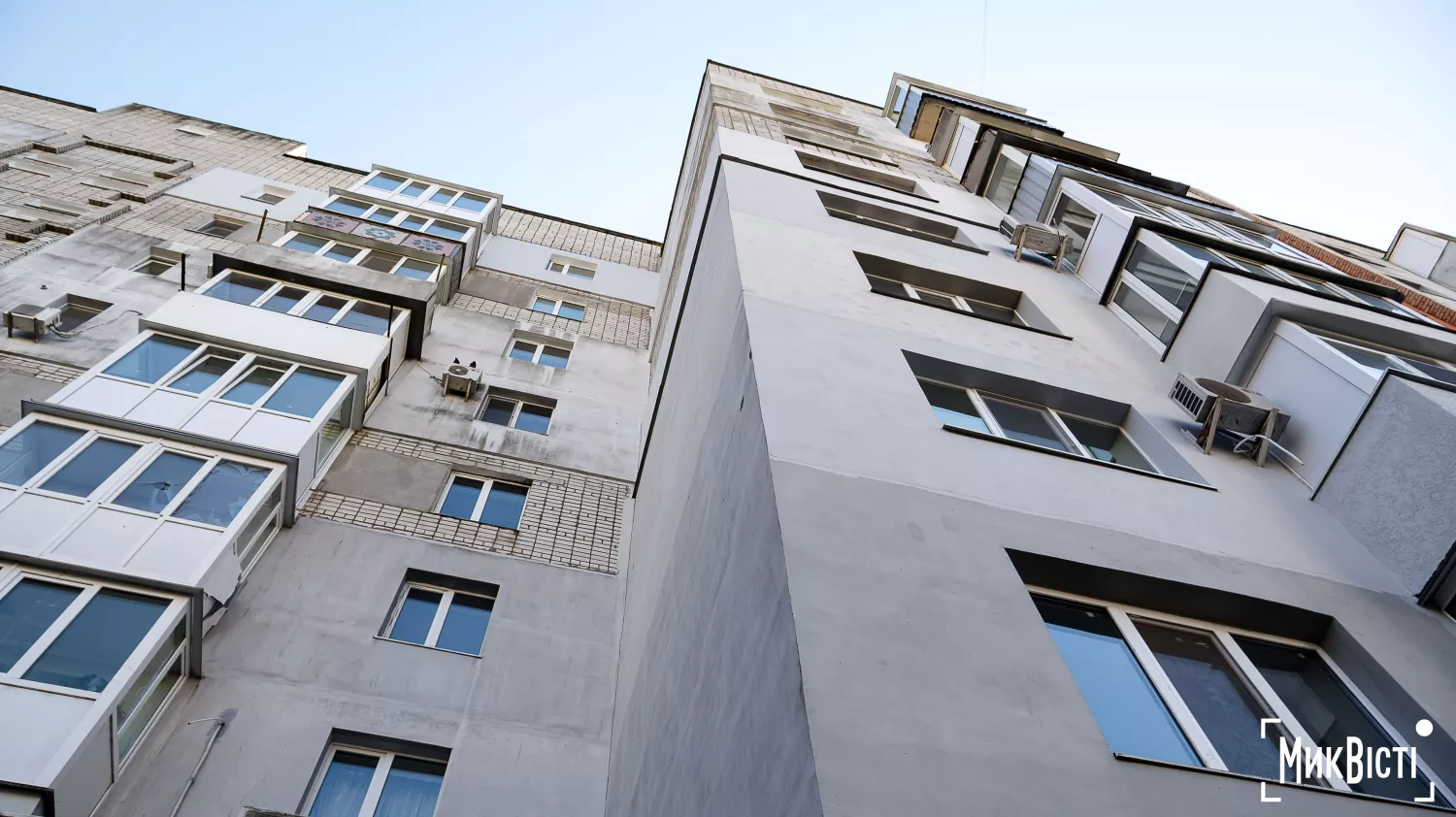Reviving Mykolaiv's residential areas: Beyond repairs, toward comfort
- News of Mykolaiv
-
•
-

- Yuliia Boichenko
-
•
-
17:30, 24 April, 2025
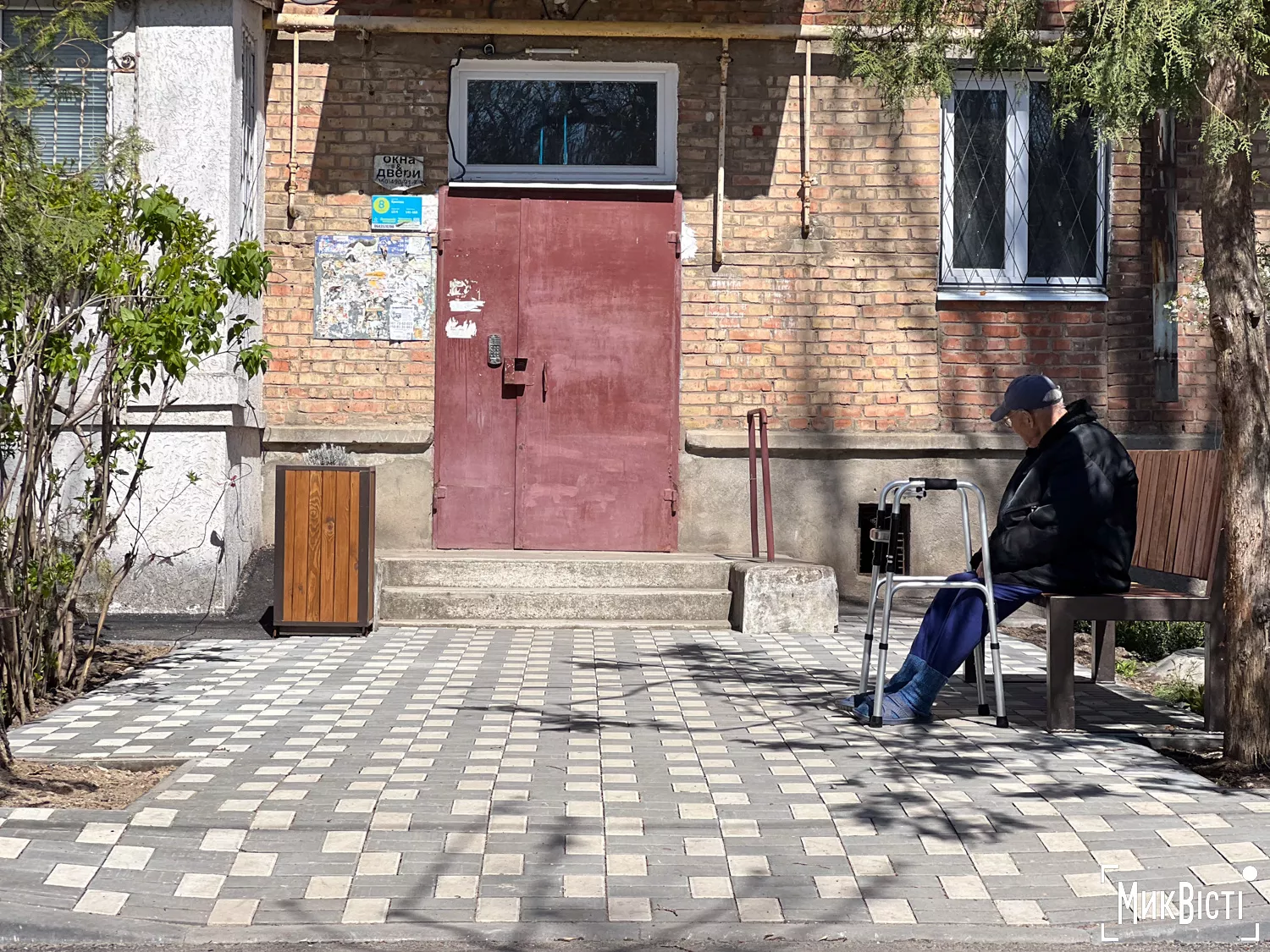 A resident of the Lisky neighbourhood has a rest on the renovated adjacent territory, April 2025, photo: NikVesti
A resident of the Lisky neighbourhood has a rest on the renovated adjacent territory, April 2025, photo: NikVestiWhat does each of us imagine when we hear the word «restoration»? Usually it is something large-scale, grandiose, with a bright ribbon at the opening. But in reality, recovery takes many forms. And it often starts with something as simple as replacing a window broken by shelling, removing debris or filling a sinkhole near the entrance with rubble. In Mykolaiv, this is the responsibility of the municipal services.
And the Department of Housing and Communal Services and international partners are engaged in a more global recovery. Some are addressing immediate needs, others are investing in long-term reconstruction projects.
NikVesti found out how damaged residential buildings are being restored to life in the city today, who is doing it, and what problems remain.
Who is restoring houses in Mykolaiv?
Mykolaiv's utilities are the first to start working on the restoration of houses and adjacent areas after the shelling. Usually, these are employees of utility companies «ELU Avtodorig», «Parks», «Mykolaivkomuntrans», «Pilot» and district administrations.
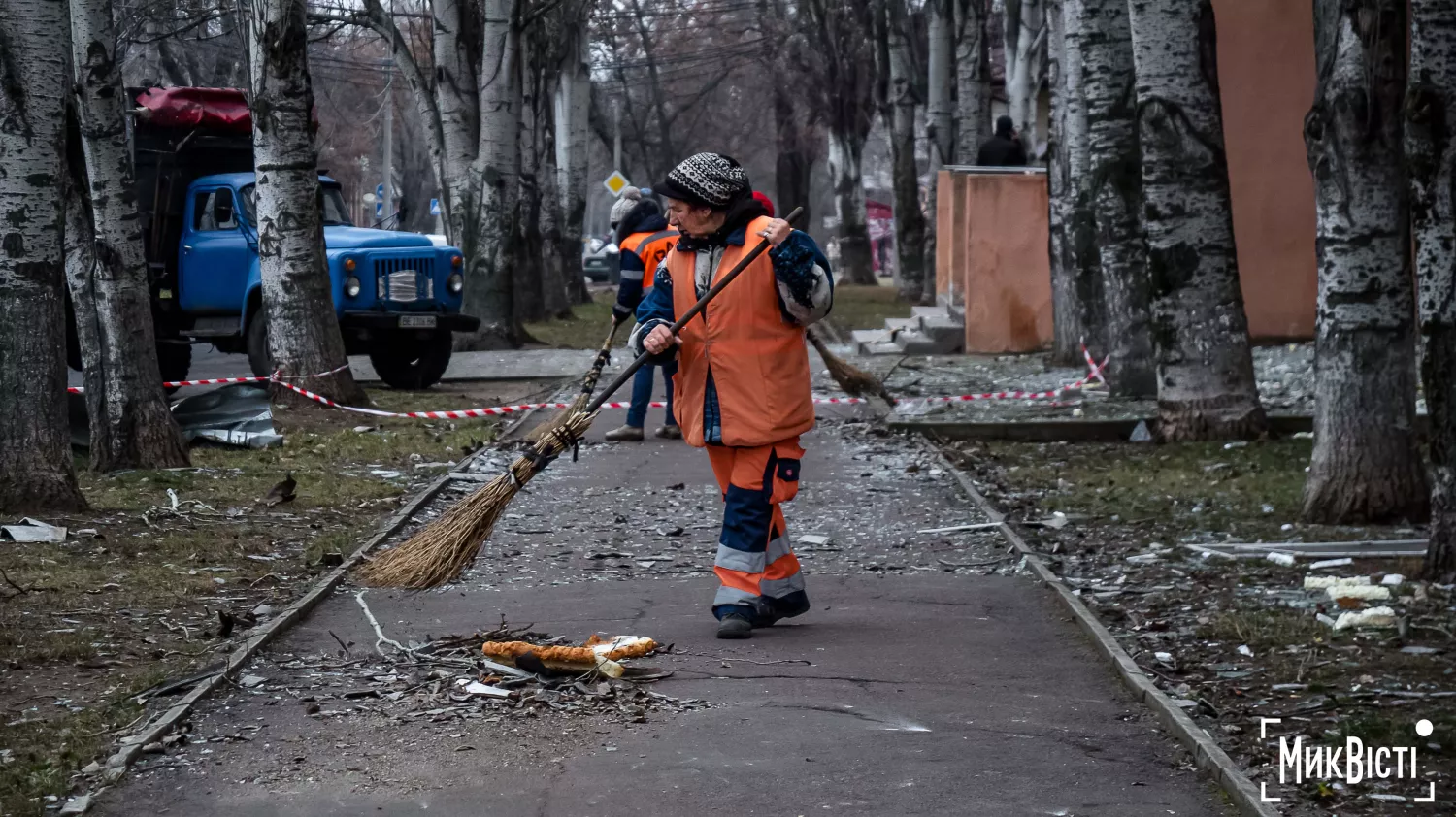 Utility workers clean up the aftermath of the hit by Shaheds in Mykolaiv on 21 January 2025, photo: NikVesti
Utility workers clean up the aftermath of the hit by Shaheds in Mykolaiv on 21 January 2025, photo: NikVestiWorkers and equipment arrive at the sites immediately after the rescuers. They help to cover the damaged roofs, board up windows with OSB boards, and clean up yards: they clear driveways and sidewalks of debris and rubble. Their work can be called «emergency» recovery, because they are helping the citizens with the first priority temporary solution to the problem.
«We will work as long as it takes. Since this morning, 24 workers have been on site. We have set up two points for cutting OSB boards and distributing the film to residents,» said Ihor Holovatyi, head of the company «Pilot», after the red shelling of the city.
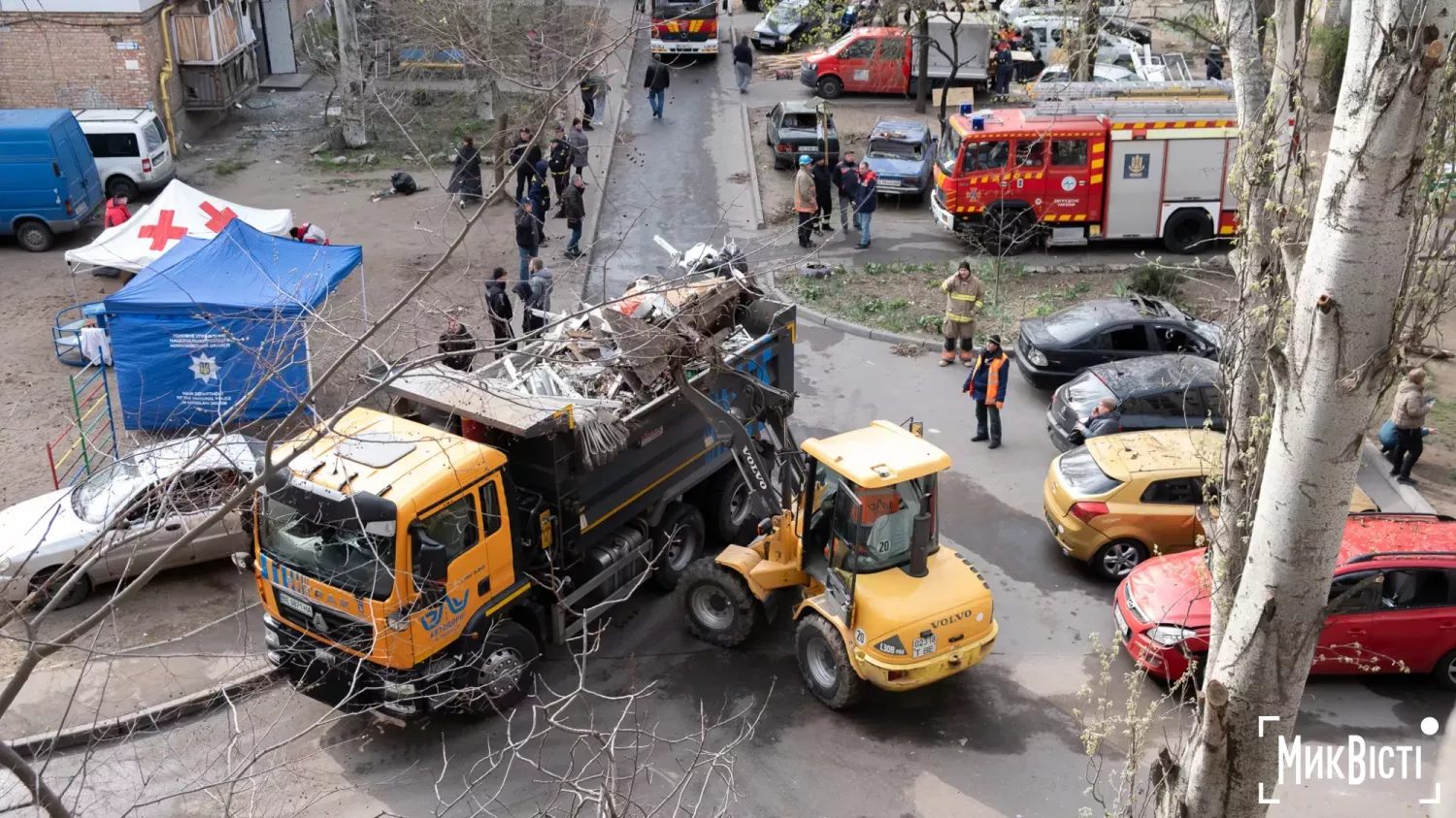 Equipment of the utility company involved in the aftermath of the night attack by Shahed drones on Mykolaiv, 10 April 2025, photo: «NikVesti»
Equipment of the utility company involved in the aftermath of the night attack by Shahed drones on Mykolaiv, 10 April 2025, photo: «NikVesti»The Department of Housing and Communal Services of the city council is responsible for the long-term restoration of the buildings. It is responsible for returning residents of the affected apartment buildings to safe and comfortable housing. To do this, the Housing and Utilities Department carries out the following work:
-
Technical inspection and expertise. The Department regularly announces tenders for such inspections to determine the extent of damage and necessary repairs.
Sometimes, however, residents disagree with the results of the examinations and order additional ones. For example, the destroyed house at 32 Admiralska Street was originally planned to be demolished. But the residents were categorically against the dismantling because they were sure that the technical report would show a positive result in their favour. Subsequently, an examination showed that the destroyed building could be restored, but now there is no money in the city budget for this.
 A resident of the building at 32 Admiralska Street shows the destroyed building, April 2024, photo: NikVesti
A resident of the building at 32 Admiralska Street shows the destroyed building, April 2024, photo: NikVestiThe situation with the house at 54 Krylova Street is a little different. Three examinations have already been carried out there. The last one showed that part of the house still needs to be dismantled. Only after this work can another technical report be ordered, which will answer whether the structure can withstand further additions to rebuild the residents' homes.
-
Holding tenders and selecting contractors. If the survey shows that the building can be restored, the Department of Housing and Communal Services announces tenders for repair work. This includes both routine repairs and major renovations of buildings.
In terms of numbers, in 2023, the department managed to overhaul 4 buildings, and 140 underwent routine repairs.
The figures for 2024 are somewhat lower: 5 buildings were repaired with major repairs, and another 22 were repaired with minor repairs, said Artem Sapozhnyk, Deputy Director of the Housing and Communal Services Department.
«We have repaired 22 residential buildings with current repairs, including replacement of windows, installation of ramps, and repair of utility networks. As for the roofs, 29 roofs have been restored. As part of the overhaul, we restored 5 houses with significant damage to structural elements,» he said.
In 2025, the Department of Housing and Communal Services is going to complete the restoration of 5 houses for which it has already conducted procurement and signed contracts with contractors last year. However, this year the city does not plan to rebuild residential buildings destroyed by Russian shelling.
Mykolaiv's budget does not currently have money to restore such buildings, explained Dmytro Bezdolnyi, director of the Department of Housing and Communal Services.
«Unfortunately, with the withdrawal of personal income tax from the military, we don't have enough money to repair, let alone build new ones. In addition, in fact, people receive certificates for which they can buy other housing. So I don't see a critical problem here — many people have already taken advantage of this opportunity and have new homes,» explained Dmytro Bezdolnyi.
Denmark is restoring residential areas in Mykolaiv
International partners are currently involved in the restoration of houses in the city. The city is already restoring destroyed residential neighbourhoods: two locations in the Lisky district and one in the Korabelnyi district. Six contractors are working on the restoration of the neighbourhoods. The first works started a year ago in the spring of 2024.
In total, residents of 42 high-rise buildings in all three locations are having new balconies and windows installed in their apartments and entrances. However, the rest of the work varies between locations:
-
In Korabelnyi district, children's and sports grounds are being built. These works have now been completed;
-
In the Lisky neighbourhood, intra-quarter passages are being arranged: pedestrian paths, parking spaces, a carriageway, and recreation areas with benches and bins. These works are expected to be completed by the summer of 2025.
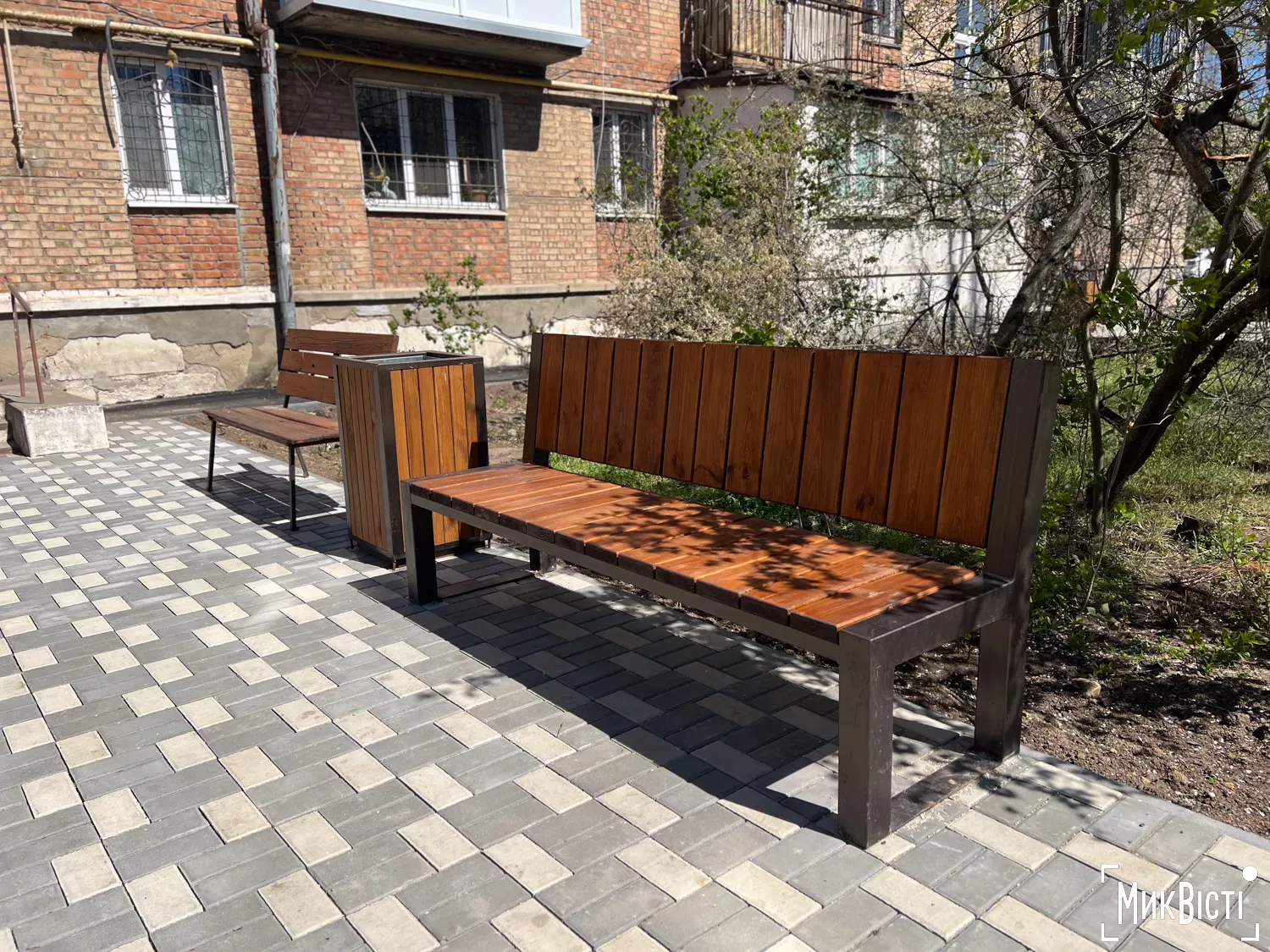 A new bench and trash bin near an apartment building in the Lisky neighbourhood, April 2025, photo: NikVesti
A new bench and trash bin near an apartment building in the Lisky neighbourhood, April 2025, photo: NikVesti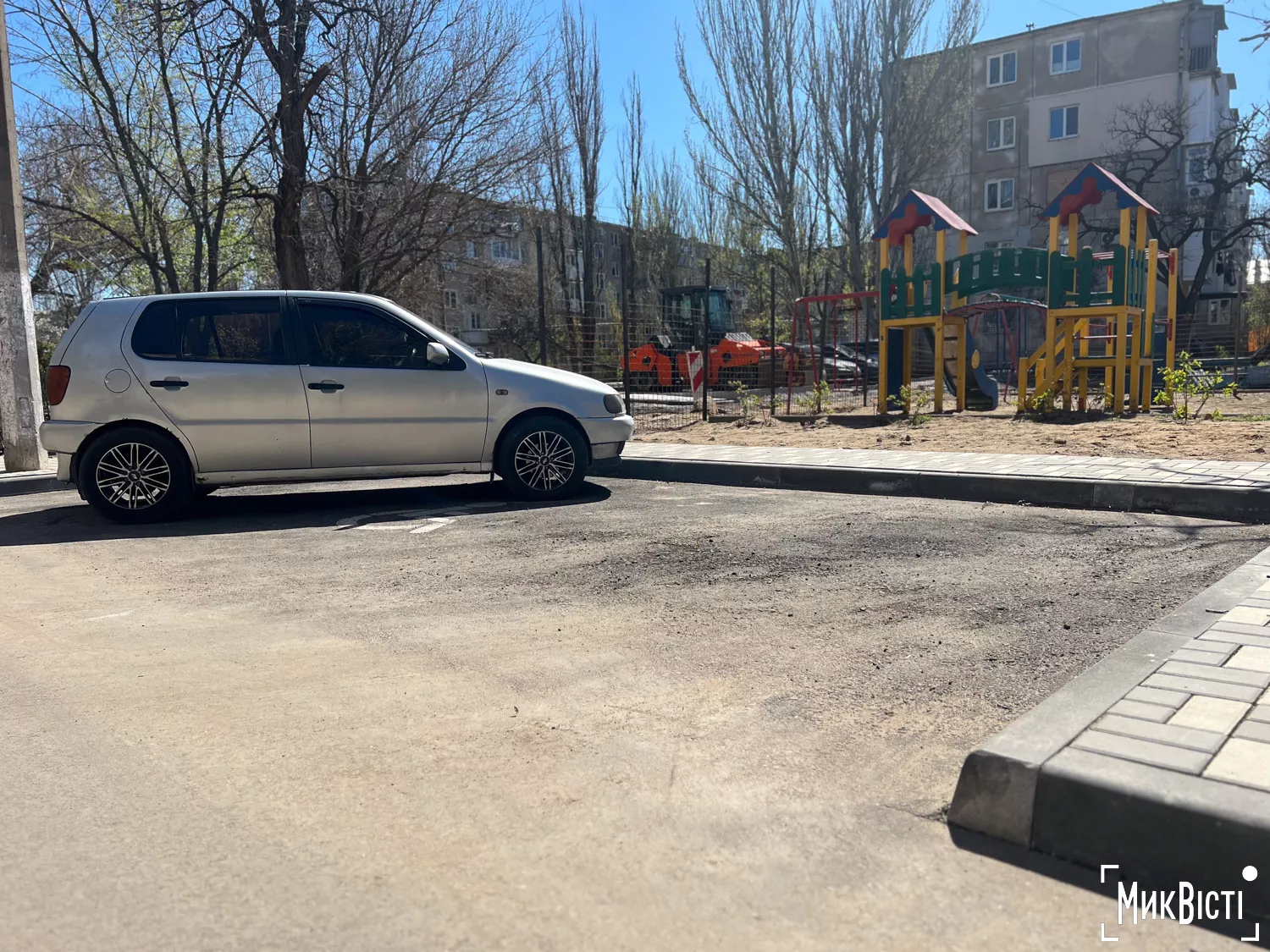 A car park near one of the residential buildings in the Lisky neighbourhood, April 2025, photo: NikVesti
A car park near one of the residential buildings in the Lisky neighbourhood, April 2025, photo: NikVestiThe Danish government is funding the restoration of residential neighbourhoods. But the idea of restoring these neighbourhoods was proposed by the city council, Jakob Hansen, Head of the Office of the Royal Danish Embassy in Mykolaiv, explained in a comment to NikVesti.
 Jakob Hansen, Head of the Office of the Royal Danish Embassy in Mykolaiv, at the celebration of the city's day in Mykolaiv. Photo by NikVesti
Jakob Hansen, Head of the Office of the Royal Danish Embassy in Mykolaiv, at the celebration of the city's day in Mykolaiv. Photo by NikVestiThe final decision to start restoring the neighbourhoods was made at a meeting of the Steering Committee of the Partnership between Mykolaiv and Denmark back in 2023. At that time, the Danish partner organisation, the United Nations Office for Project Services (UNOPS), took over the project.
UNOPS Communications Specialist in Ukraine Mykhailo Turianytsia told us in a comment that the Office is engaged in full project support: from damage assessment to technical supervision of works.
«We conduct damage assessment, develop design and estimate documentation, look for contractors and conduct close technical supervision to ensure that the contractor complies with all international quality standards» explained Mykhailo Turianytsia.
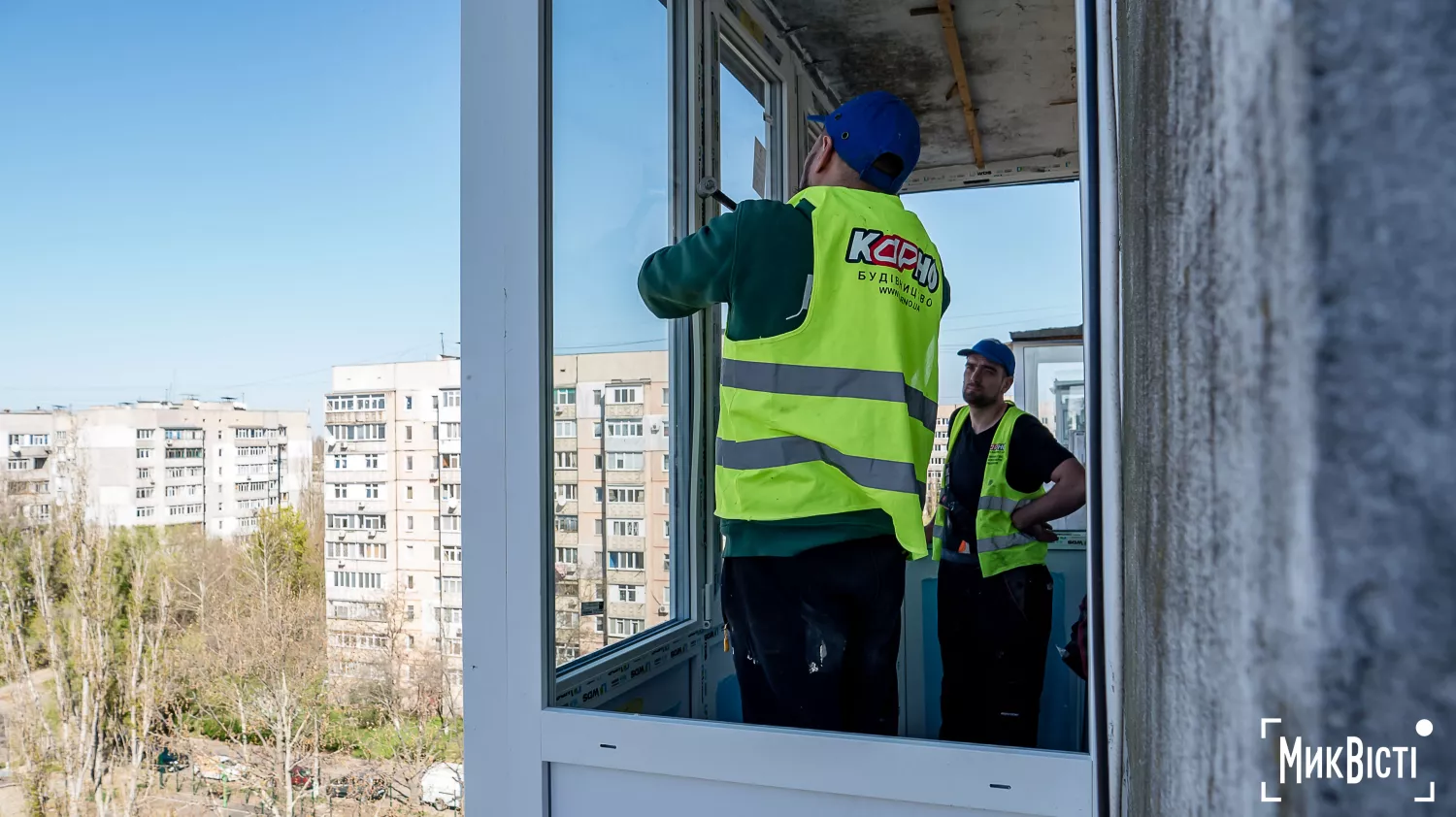 A contractor restoring a balcony in an apartment in Korabelnyi district, April 2025, photo: NikVesti
A contractor restoring a balcony in an apartment in Korabelnyi district, April 2025, photo: NikVesti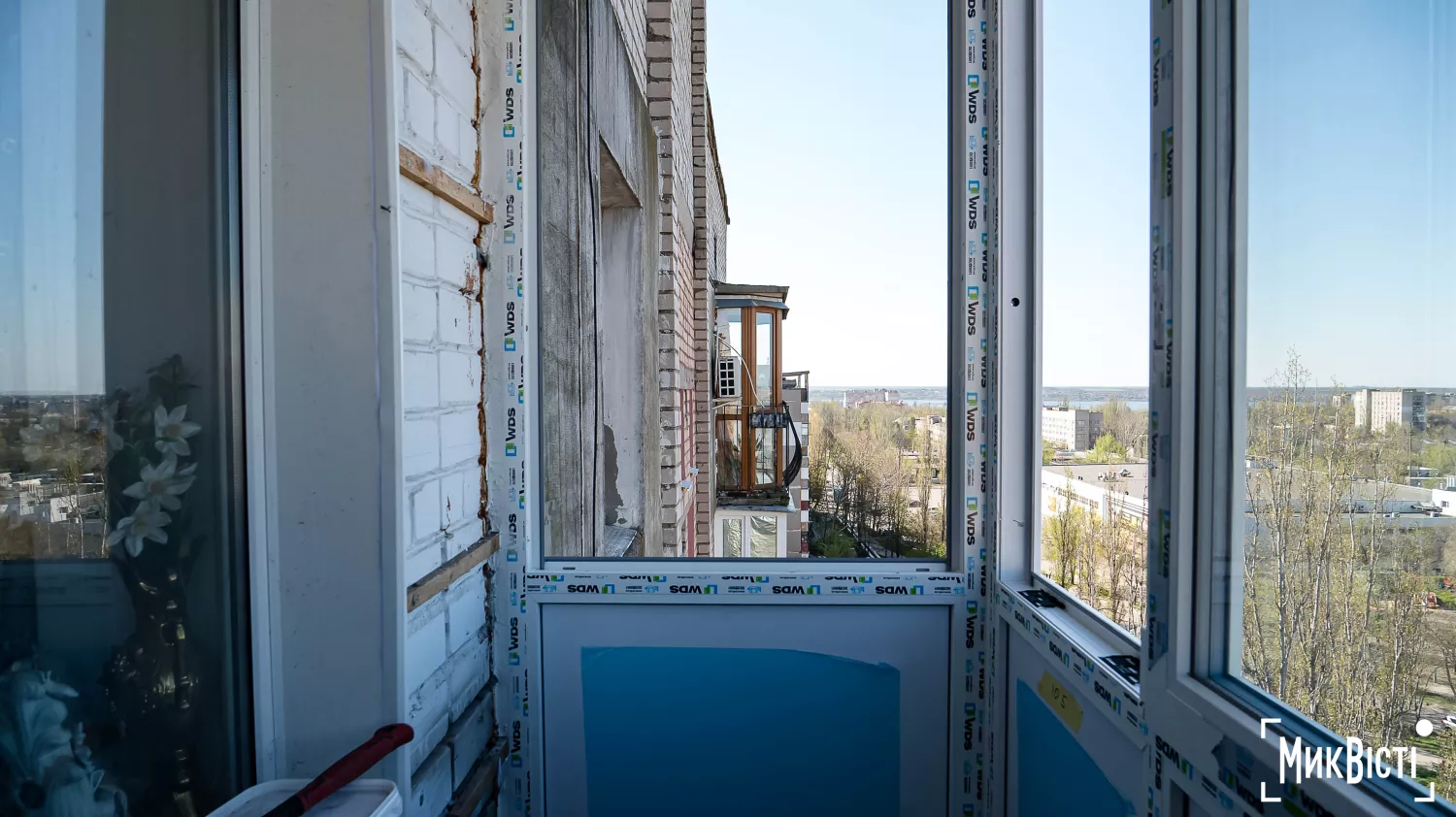 A contractor is restoring a balcony in an apartment in the Korabelnyi district, April 2025, photo: NikVesti
A contractor is restoring a balcony in an apartment in the Korabelnyi district, April 2025, photo: NikVestiBefore the work began, UNOPS and Mykolaiv's Department of Housing and Communal Services inspected damaged buildings across the city and identified which apartments needed the most restoration.
«They travelled all over the city and investigated what the needs were and which apartments were in urgent need of restoration or repair. After that, it was determined that work should begin in these neighbourhoods,» said Jacob Hansen.
At the moment, UNOPS cannot name the exact cost of all these works, as the work is not yet complete and the «project may be cheaper or more expensive than», says Jacob Hansen. However, according to the website of the state DREAM system, the restoration of these residential areas is preliminarily estimated at around 250 million hryvnias.
«We understand that there is a security risk, but on the other hand, our priority is to get people back to the city and to give them a place to live. Because we understand that the housing situation is difficult at the moment — there is simply not enough housing for people,» said Jacob Hansen.
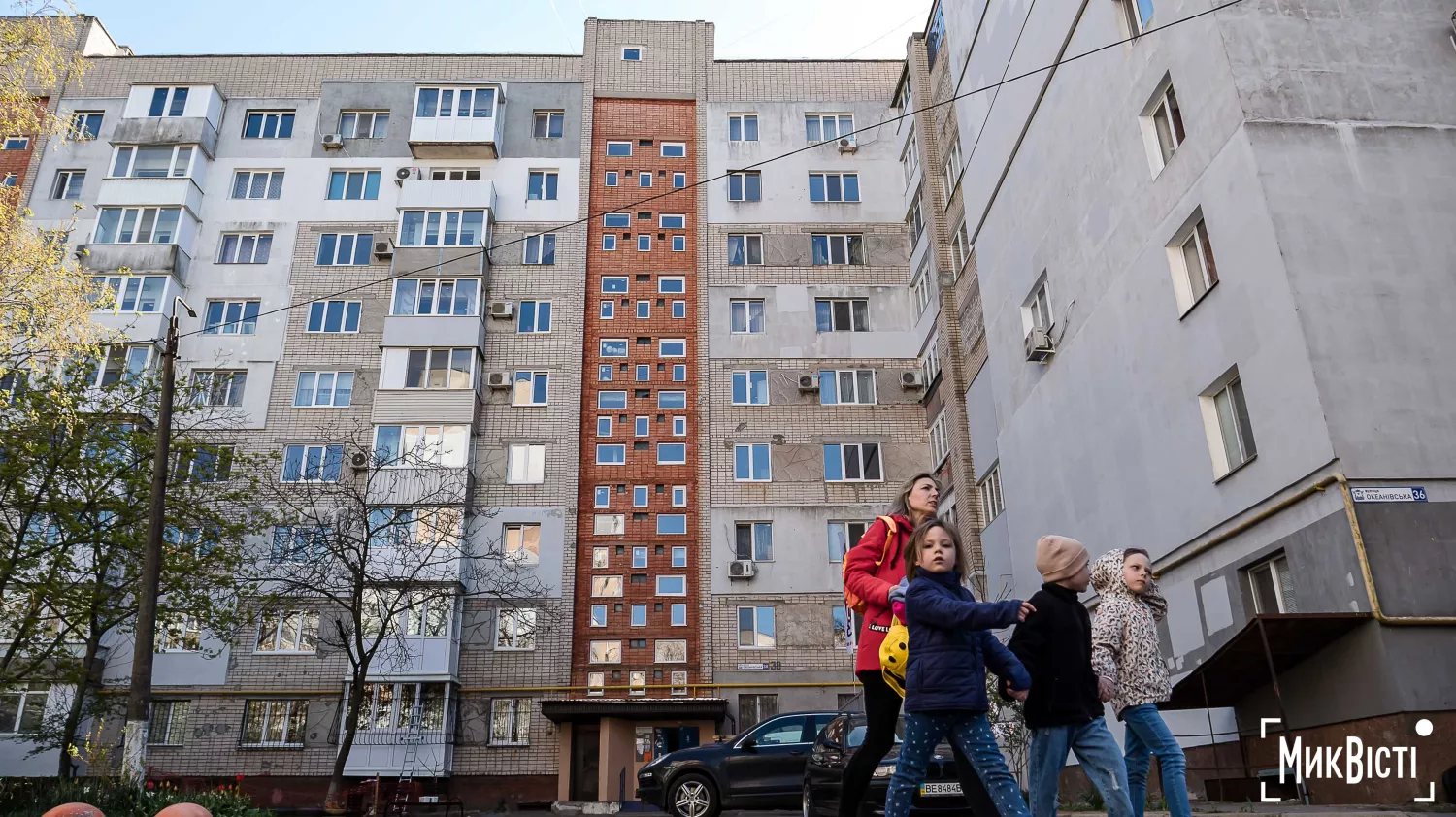 Restored windows and balconies in a residential building in Korabelnyi district, April 2025, photo: NikVesti
Restored windows and balconies in a residential building in Korabelnyi district, April 2025, photo: NikVestiAfter the completion of these works, Denmark plans to continue to finance the restoration of residential areas in Mykolaiv, Jakob Hansen told NikVesti. However, it is not yet known which neighbourhoods will be restored after that — the discussion is still ongoing.
«In fact, all districts of Mykolaiv need to be restored. The work that is currently underway should be completed this summer. After that, we will extend this project and again have to determine which districts to work in. This dialogue is already underway between the city and UNOPS, with Denmark as a donor. But there is currently no final decision on which district we will work in after the summer,» he said.
What do Mykolaiv residents think about the restoration of their neighbourhoods?
NikVesti also spoke to residents of the Lisky and Korabelnyi districts to find out their opinion on the restoration of the residential areas where they live.
«We had our balcony replaced because it was damaged by shelling. The area around our house has now been landscaped — it's great, because there are no pits anymore,» says a resident of the Lisky neighbourhood.
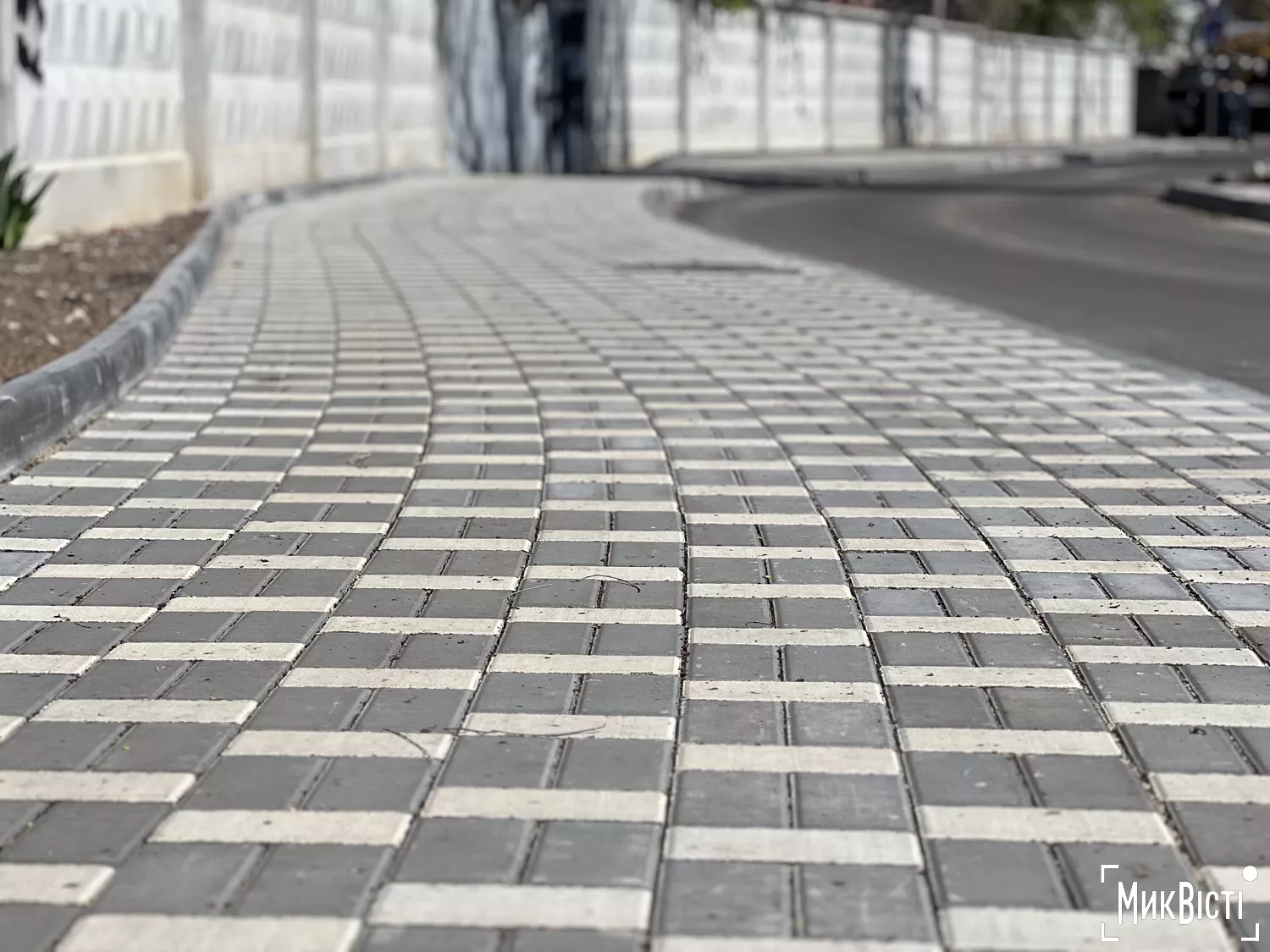 A sidewalk near one of the residential buildings in the Lisky neighbourhood, April 2025, photo: NikVesti
A sidewalk near one of the residential buildings in the Lisky neighbourhood, April 2025, photo: NikVesti«Before the work began, everything looked very bad. From the 1st to the 9th floor, there were no windows at all, and virtually no balconies. Now everything has been replaced. We personally got a balcony and a loggia. We are very grateful,» says Larysa, a resident of Korabelnyi District.
 Restored windows and balconies in a residential building in Korabelnyi district, April 2025, photo: NikVesti
Restored windows and balconies in a residential building in Korabelnyi district, April 2025, photo: NikVesti«The contractor is working on the project as required. The technology is also great. Even look at the cool benches and litter bins they installed for us. I honestly didn't even think it would happen. People are all happy because it was all replaced for free. We are grateful. We thank both UNOPS and the contractors,» says Serhii, a resident of the Lisky neighbourhood.
«We had windows replaced in our apartments and entrances. Even the appearance of the house changed immediately, it became very beautiful. Because back in 2022, all the windows here were blown out and since then they have been simply covered with plywood,» said Svitlana, a resident of the Korabelnyi district.
In general, all residents say they are grateful to the Danish partners for the restoration of their residential neighbourhoods, but point out several important points that they believe need to be improved. This is mainly the case with residents of the Lisky neighbourhood, where work is underway to improve the adjacent territory.
More parking spaces are needed
Even today, there are not enough car parks in Lisky to accommodate the number of cars owned by local residents, says Mykola, a resident of the neighbourhood.
«Of course, there are already not enough parking spaces: there are 15 parking spaces for six houses. You can see that right now all the spaces are taken, and that's not all the cars. You know, the war will end and there will be twice as many cars here,» he explained.
 A car park near one of the residential buildings in the Lisky neighbourhood, April 2025, photo: NikVesti
A car park near one of the residential buildings in the Lisky neighbourhood, April 2025, photo: NikVestiAnother resident of the neighbourhood says that some of the parking spaces in Lisky could have been made more spacious, as the area around them allowed for such work.
«Personally, I think that there is not enough parking space for all of us. For example, the car park could have been made bigger, because the space and area allows it. But they made a very small one,» the woman believes.
Serhii, a resident of the neighbourhood, also talks about the lack of parking spaces, but adds that he is sympathetic to this, as the contractor is working in accordance with the already approved neighbourhood rehabilitation project.
«We talked to the donor organisation UNOPS, and they corrected a lot of things. It is clear that a project is a project. Much cannot be adjusted because the project has already been approved. But yes, there are not enough park places,» Serhii said.
Residents are concerned about the changes in the ground level
After the landscaping works in the neighbourhood, the ground level dropped. Residents are worried that during the rains, entire yards will be in water.
«You see, the most important thing here is the land that needs to be brought in. Look at this playground, when it rains, children will swim here. Before that, the ground level was the same, but now it has been raised higher: paths have been made and borders installed. So now we have to look for land somewhere. This is a problem,» says Mykola, a resident of the neighbourhood.
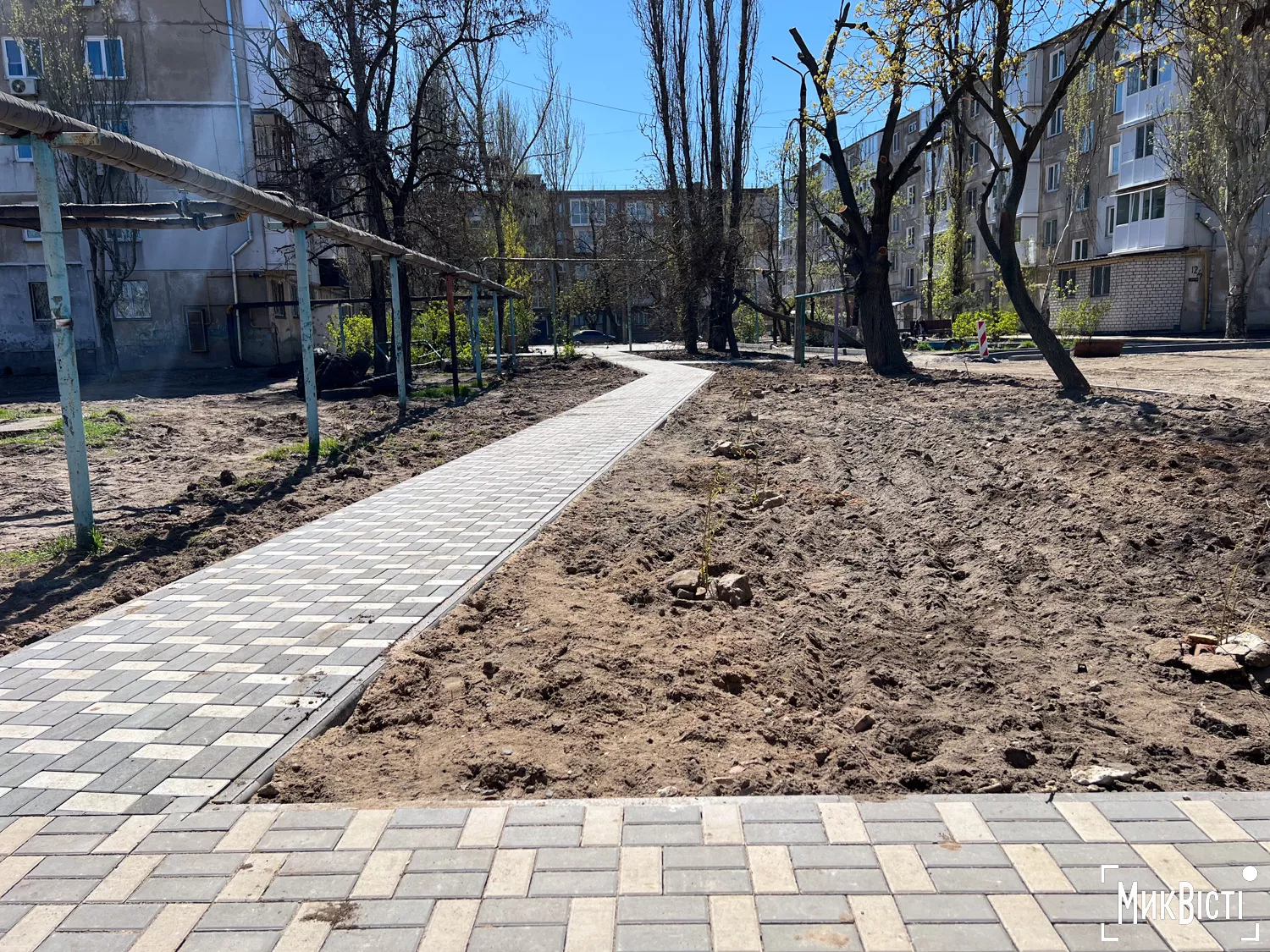 A sidewalk near one of the residential buildings in the Lisky neighbourhood, April 2025, photo: NikVesti
A sidewalk near one of the residential buildings in the Lisky neighbourhood, April 2025, photo: NikVesti Employees of a contractor working on the restoration of residential areas in the Lisky neighbourhood, April 2025, photo: NikVesti
Employees of a contractor working on the restoration of residential areas in the Lisky neighbourhood, April 2025, photo: NikVestiAnother resident, Serhii, says that they managed to find the necessary amount of land, but it is very expensive, and this money is not provided for in this project.
«There are problems with the landscape. I talked to the contractor, and we found the land, in principle, for them. But I heard that the land does not suit them and so on. I understand that this is a big expense, because at least 100 cubic metres of earth needs to be brought here,» he explained.
A playground was not included in the project, but residents are looking for money on their own
There is an outdated playground in the middle of the residential buildings where the reconstruction work is underway, says Serhii, a resident of Lisky. It was not included in the project to restore residential areas. Therefore, the man says, he will look for funds to restore the playground and build a sports ground on his own.
«Landscaping is very good, but we have a big question about the playground and sports ground. Because children are our future. We know that 50% of children have already gone abroad. And we need to encourage those who are left. How can we encourage them if they don't even have a place to play sports?» says Serhii.
He also added that he is currently seeking help in this matter from various charitable organisations.
«From the very beginning, there were also questions about the playground and sports ground. I asked these questions. I was told that something would be decided. But today there are no changes. That's why we are looking for investments through the Red Cross, and other donor organisations.
But, you know, if you look and look for something bad, you can always find it. However, I still look at it from a positive point of view: our district has been reconstructed. It's not a complete reconstruction, but it's been done. And it's great,» he added.
 Restored windows and balconies in a residential building in Korabelnyi district, April 2025, photo: NikVesti
Restored windows and balconies in a residential building in Korabelnyi district, April 2025, photo: NikVestiAfter two years of full-scale war, the first examples of systematic restoration of residential infrastructure began to appear in Mykolaiv. Some of the work is undertaken by the city, including technical inspections, tenders, roof and utility repairs. Larger infrastructure projects are carried out by international partners, including the Danish government and UNOPS.
There are no quick fixes or easy answers in this story. But there is a result: in several districts, new windows have replaced plywood, and paths and benches have replaced broken asphalt. But recovery is not only about physical objects, but also about people's trust in the process.
Yuliia Boichenko, NikVesti

This material was produced as part of the "Improving Ukrainian Media Resilience" project, implemented by the Fondation Hirondelle (Switzerland) and IRMI, the Institute for Regional Media and Information (Ukraine). The project is funded by Swiss Solidarity.

Чому ви читаєте «МикВісті»? Яка наша діяльність найбільш важлива для вас? Та чи хотіли б ви стати частиною спільноти читачів? Пройдіть опитування, це анонімно і займе 5 хвилин вашого часу


